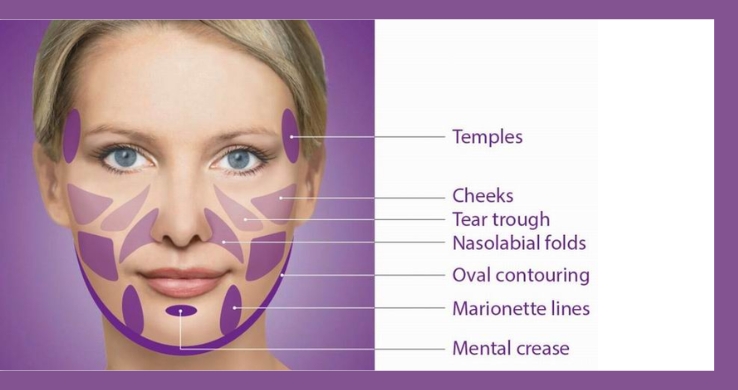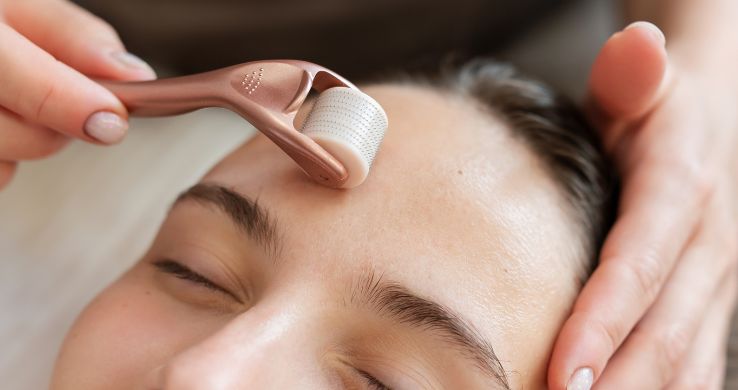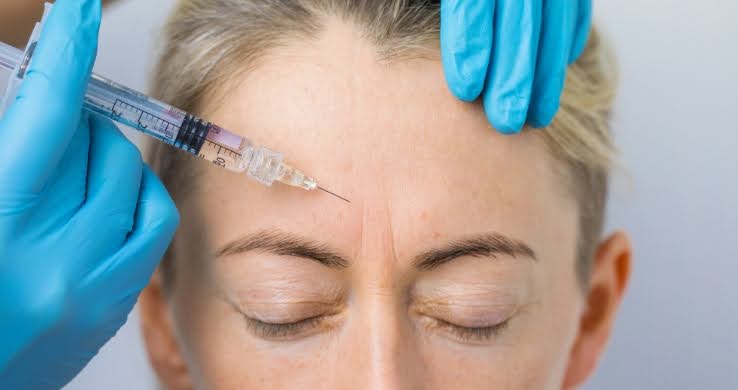Sculptra is an injectable treatment that helps restore facial volume and smooth out wrinkles. It doesn’t add volume directly by working, but it encourages your natural collagen production. In this blog post, we will discuss all the benefits, risks, and results of Sculptra treatment.
How Sculptra Works?
Sculptra is made from poly-L-lactic acid, a synthetic material that is biocompatible and gradually absorbed by your body. Once injected beneath the skin, Sculptra acts as a collagen stimulator rather than staying in place like traditional fillers.
As the poly-L-lactic acid particles break down, your skin responds by ramping up collagen production in the treated areas. Over several weeks, you may notice your face becoming fuller and lines appearing less pronounced. Results tend to develop gradually and can last for more than two years in many people.
The injection targets areas that have lost volume or developed wrinkles, such as the cheeks, temples, and smile lines. Most patients require a series of treatments, spaced a few weeks apart, to achieve the best outcome. Side effects are generally mild and can include swelling, bruising, or lumps under the skin.
Is Sculptra a Filler?
Sculptra is classified as a biostimulatory filler, which sets it apart from most other facial fillers. Instead of instantly plumping the skin with gel-based substances like hyaluronic acid, Sculptra triggers your body to replace lost collagen over time.
Traditional fillers work by adding immediate volume to areas that are hollow or wrinkled. In contrast, Sculptra produces a gradual, natural-looking thickening of the skin’s support structure. This makes results subtler and longer-lasting than many alternatives.
You’ll typically see the most dramatic results after completing all recommended sessions, often spaced over several months. For a detailed look at where Sculptra is used and how it differs from other products, visit the section on Sculptra injectable treatment.
Sculptra Injections
Sculptra injections use poly-L-lactic acid to restore skin volume and improve firmness. This treatment is designed to stimulate natural collagen production, yielding results that can last up to two years.
On Which Parts Can We Use Sculptra?

Sculptra is commonly used to address areas of facial volume loss. The most frequent injection sites include the cheeks, temples, jawline, and nasolabial folds (also known as smile lines).
These injections target deep facial wrinkles and folds rather than superficial fine lines. Providers use a series of treatments, typically three sessions spread over three or four months, to gradually build up collagen and improve your skin’s structure. Results develop over time.
Sculptra is FDA-approved for injection in the cheek region to smooth wrinkles and enhance facial contouring. It is not intended for use on the lips, around the eyes, or on the forehead. Treatment plans are personalised based on your facial structure and desired outcome.
Before and After of Sculptra
When you review Sculptra before and after results, you can expect gradual improvements in skin thickness, elasticity, and volume. Changes typically become visible several weeks after the first session and continue to improve with additional appointments.
Before treatment, deep wrinkles and hollow areas are usually more pronounced. After Sculptra injections, these areas appear smoother, and facial contours are subtly lifted. The outcomes look natural because the treatment stimulates your collagen.
Common effects seen in before and after cases include reduced nasolabial folds and fuller cheeks. Consistent follow-up and adherence to your provider’s recommendations are essential for maintaining improvements.
When Do Sculptra Results Appear?
Sculptra is a popular injectable used to restore facial volume and stimulate collagen production. Results appear gradually and have a reputation for lasting longer than some other dermal fillers.
How Long Does Sculptra Last?
Sculptra provides results that usually last up to two years after a complete treatment series. In some cases, with optimal skin care and health, results may last as long as five years. Individual factors, such as metabolism, age, and lifestyle, all play a role in the durability of your results.
Sculptra works differently from hyaluronic acid fillers because it stimulates your body’s collagen production. This process is slower, but the results are often more natural-looking and long-lasting. Your provider may recommend touch-up sessions to maintain the effects over several years.
Sculptra Pros and Cons
Advantages:
- Gradual, natural-looking results
- It can last up to five years in some individuals
- Safe for most skin types
- Stimulates collagen for improved skin texture
Disadvantages:
- Results are not immediate; it can take several months to see full improvement
- Requires multiple sessions spaced over a few months
- Higher cost due to the need for more than one treatment
- Some swelling, redness, or tenderness at injection sites
A consultation at Effortlessway Aesthetic with a qualified provider helps you weigh the benefits and risks based on your needs.
What is the Sculptra Injection Cost?
Sculptra injections are priced per vial, and costs can vary widely depending on your provider, location, and the extent of treatment. Access to qualified professionals is vital to ensure safety and effective results.
The average cost of Sculptra injections in the United States falls between $600 and $1,000 per vial. For a typical treatment plan, you may require several vials, resulting in a total price range of $2,000 to $6,000, especially for multiple sessions or full-face corrections. You can see current pricing estimates and details about Sculptra injection costs on leading review sites.
Sculptra Compared To Other Treatments
Sculptra is designed to gradually stimulate collagen growth in your skin, providing long-lasting volume and natural-looking results. Alternatives such as Radiesse differ in meaningful ways, including how quickly results appear, the type of filler material, and how long the effects last.
Radiesse vs Sculptra
Radiesse utilizes calcium hydroxylapatite microspheres to quickly restore facial volume. Results from Radiesse are often visible right after treatment, which appeals if you want immediate enhancement.
Sculptra, on the other hand, uses poly-L-lactic acid that works gradually, taking weeks to months for full improvement. Unlike Radiesse, Sculptra encourages your body to build collagen over time, which can lead to longer-lasting effects, sometimes up to two years.
In terms of texture, Radiesse is thicker and better suited for deeper folds, while Sculptra is typically preferred for broader areas that need subtle, uniform volume. Cost per session may be comparable, but Sculptra treatments often require multiple sessions for optimal results, whereas Radiesse might achieve your goals in a single visit.
Both are FDA-approved, but the choice depends on how quickly you want results, your desired longevity, and the specific concerns you’re targeting.
Frequently Asked Questions
Sculptra is used for restoring facial volume, stimulating collagen, and can also be used in non-surgical body enhancements. If you are considering Sculptra, it is essential to understand its effects, safety profile, aftercare requirements, and typical costs.
Where is Sculptra injected?
Sculptra is added into the deep dermis or subcutaneous layer of the skin to restore lost volume and remove wrinkles.
Who is the candidate for Sculptra?
Individuals seeking to address wrinkles, age-related volume loss, and skin laxity, particularly in areas such as the cheeks, jawline, and temples, are ideal candidates for Sculptra.
What happens before a Sculptra injection?
Before Sculptra treatment, you need to get it from trusted providers like Effortlessway Aesthetic. Discuss your concerns or any medical history before going for Sculptra.
What is the recovery time for a Sculptra injection?
Recovery time after Sculptra injection is typically short; patients usually return to their daily activities immediately. Sometimes, there is redness, mild swelling, and bruising at the injection site, which usually disappear within a few days.
What are the potential side effects of Sculptra treatments?
You may notice mild swelling, redness, or bruising at injection sites. Some people experience tenderness or small lumps as the area heals. Significant complications are rare when a qualified provider performs the procedure. You should report persistent pain, severe swelling, or changes in skin colour to your healthcare provider.
How long do the effects of Sculptra last compared to other fillers?
The results from Sculptra treatments can last up to two years or more, which is often longer than most hyaluronic acid-based fillers. This is because Sculptra encourages your body to produce new collagen, helping maintain volume for an extended period. Maintenance sessions may be needed to sustain optimal results over time.
What should one expect during and after Sculptra injections?
Your provider will inject Sculptra into specific areas of your skin or body using fine needles. The treatment typically takes 30-60 minutes per session. Afterwards, you can expect some swelling or bruising that usually subsides within a few days. Most people can return to regular activities immediately following the appointment.
Are there any specific aftercare instructions for Sculptra treatments?
You should massage the treated area for 5 minutes, 5 times per day, for approximately 5 days. Applying an ice pack can help reduce swelling or discomfort. You will need to avoid intense sun exposure and excessive heat for a short period after treatment.
What are the average costs associated with Sculptra procedures?
The price can range from $800 to $2,000 per vial, depending on the location and the provider’s experience. Most facial treatments require 1-2 vials, while body procedures, such as buttock augmentation, may require several vials. Multiple sessions are often recommended for optimal outcomes, which can increase the total cost.





